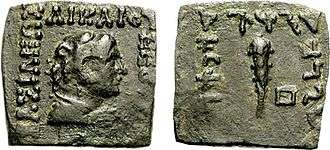Theophilos (king)
Theophilos (Greek: Θεόφιλος) was a minor Indo-Greek king who ruled for a short time in the Paropamisadae. He was possibly a relative of Zoilos I and is only known from coins. It is possible that some of Theophilos' coins in fact belong to another ruler, in Greek Bactria, during approximately the same period.
| Theophilos | |
|---|---|
 Portrait of Theophilos | |
| Indo-Greek king | |
| Reign | 130 BCE or 90 BCE |

Obv: Bust of king Theophilos. Bead and reel contour. Greek Legend: ΒΑΣΙΛΕΩΣ ΔΙΚΑΙΟΥ ΘΕΟΦΙΛΟΥ "Of Fair/Just King Theophilos".
Rev: Herakles.

Time of reign
While Bopearachchi suggests c. 90 BCE, R. C. Senior believes that Theophilos ruled in the 130s BCE. Both numismatics do however suggest that the reigns of Theophilos and Nicias were adjacent.
Coins of Theophilos
Just like Zoilos I, Theophilos struck Indian silver coins with Herakles, a common symbol of the house of Euthydemus I, and the epithet Dikaios/Dhramikasa "The Just/Follower of the Dharma". The monograms are mostly the same as those of Nicias. The bronzes have similar inscriptions.
Bronzes of Theophilos:
 Herakles with lion skin, and his club on the reverse.
Herakles with lion skin, and his club on the reverse.
A Bactrian king Theophilos?
However, there is a wholly different, and very rare, Attic coinage of a king Theophilos. Found in Bactria, these coins feature a reverse with a seated Athena with Nike, a different title Autokrator "Autocrat King" (Greek: ΒΑΣΙΛΕΩΣ ΑΥΤΟΚΡΑΤΟΡΟΣ), and also a separate monogram. Although this is not a very common occurrence on Indo-Greek coins, the coins of Theophilos have generally been accepted as belonging to one unique king. Bopearachchi has supported this proposition by pointing at the similarity between the portraits and the identical treatment of the diadem (one end straight, one end crooked).
Against this, Jakobsson[1] argues that the coins issued by the later Indo-Greek kings for export into Bactria were consistently similar to these kings' regular Indian coinage. Consequently, the coins of Theophilos Autokrator were not such export issues, but should belong to a Bactrian ruler. Jakobsson suggests that Theophilos Autokrator was a Bactrian princelet who briefly maintained himself in some part of Bactria, after the Hellenistic kingdom there had been vanquished by nomads, presumably in the 120s BCE.
See also
Notes
- Jakobsson, J: Theophilos Autokrator, a last Bactrian king? ONS Journal 202 (2010).
- O. Bopearachchi, "Monnaies gréco-bactriennes et indo-grecques, Catalogue raisonné", Bibliothèque Nationale, Paris, 1991, p.453
- Quintanilla, Sonya Rhie (2 April 2019). "History of Early Stone Sculpture at Mathura: Ca. 150 BCE - 100 CE". BRILL – via Google Books.
References
- The Greeks in Bactria and India, W.W. Tarn, Cambridge University Press.
| Preceded by Diomedes |
Indo-Greek ruler in Paropamisadae c. 90 BCE |
Succeeded by Nicias |